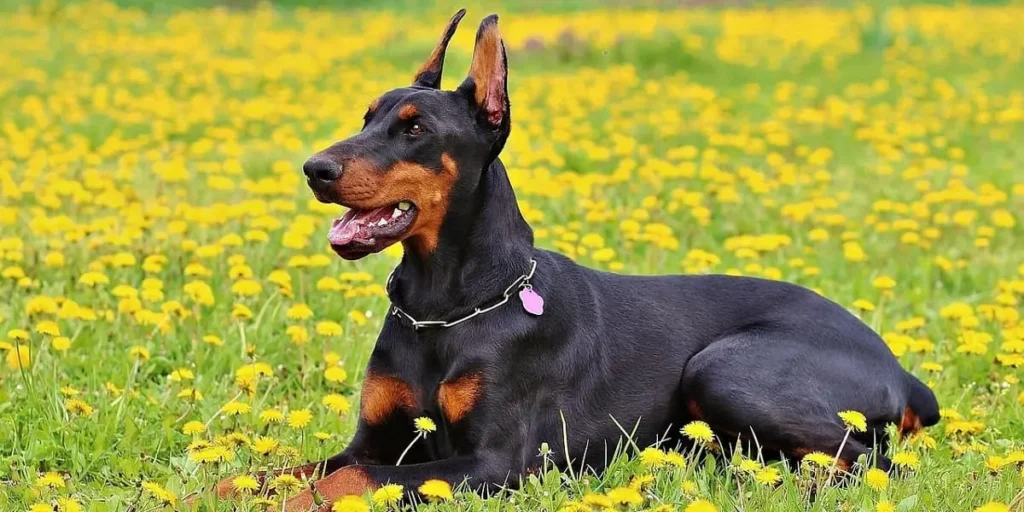Table of contents
The Dobermann is a German breed, often nicknamed the police dog. It is both a devoted family companion and an excellent guard dog. Strong, elegant, and attentive, it watches over its home and family while also being gentle and affectionate. Despite its imposing appearance, the Dobermann is loyal and sensitive. It requires consistent training and exercise to thrive.
Breed Information
| Characteristic | Details | Female | Male |
| Coat type | Short | ||
| Origin | Germany | ||
| Size | Large | ||
| Head shape | Long | ||
| Weight | 32–35 kg | 40–45 kg | |
| Height | 61–68 cm | 68–72 cm |
History of the Breed
The Dobermann originated in Germany and was named after its first breeder, Friedrich Louis Dobermann (1834-1894). A tax collector and dogcatcher, he sought a protective dog with courage and bite. The breed was developed using butcher dogs and shepherds, particularly from Thuringia, and shares ancestry with the Rottweiler.
The Dobermann quickly gained popularity as a guard, defense, and police dog, as well as a loyal companion. The Fédération Cynologique Internationale (FCI) officially recognized the breed on January 1, 1955.
Physical Characteristics
- Coat: short, close-fitting, harsh in texture, without undercoat.
- Color: black or brown with clearly defined tan markings above the eyes, on the cheeks, muzzle, throat, chest, feet, thighs, and under the tail.
- Head: elongated, strong skull, well-proportioned with developed muscles and brow arches.
- Ears: set high; cropped ears stand erect (where legal), natural ears hang. Ear cropping is banned in many countries.
- Eyes: oval, medium-sized, dark (lighter in brown-coated dogs).
- Body: strong with a prominent withers, short muscular back, long loin, broad chest, and tucked abdomen.
- Tail: set high, naturally long where docking is prohibited; if docked, usually two vertebrae remain.
Temperament and Character
Despite its intimidating appearance, the Dobermann is affectionate and rarely aggressive without reason. It is deeply loyal to its family, protective of children, and attentive to its master. Highly vigilant and naturally wary of strangers, it is a courageous and reliable guard dog. With proper socialization, it is both a loving companion and a determined protector.
Training
The Dobermann has a strong-willed personality and may show dominance, particularly toward dogs of the same sex. Early socialization and firm, fair training are essential. Positive reinforcement through play and rewards works best. Intelligent and receptive, the Dobermann enjoys working with its handler and excels when given structure and purpose.
Living Conditions
The Dobermann is sensitive to cold and damp weather and must live indoors. However, it is not suitable for small apartments. A house with a large fenced yard is ideal, allowing the dog space to exercise and patrol. The breed thrives with an active, confident owner who provides affection, guidance, and regular activities.
Health
Generally robust, the Dobermann is nonetheless sensitive to extreme cold and heat. It is predisposed to several genetic health conditions, including hip and elbow dysplasia, progressive retinal atrophy (PRA), hypothyroidism, Von Willebrand’s disease, cardiomyopathy, Wobbler syndrome, and gastric torsion. Less frequent issues include alopecia, demodicosis, bacterial folliculitis, albinism, and narcolepsy.
- Average litter size: 3–13 puppies.
- Hypoallergenic: No.
Life Expectancy
The Dobermann’s lifespan ranges from 10 to 12 years.
Grooming and Hygiene
Dobermanns shed little as they lack an undercoat. Their short coat is easy to maintain but should be brushed weekly with a grooming mitt to remove dead hair and debris. Baths are rarely needed.
Teeth should be brushed regularly to prevent tartar buildup. Nails must be trimmed if not naturally worn down, and eyes and ears should be cleaned weekly with appropriate solutions. Regular grooming maintains both health and appearance.
Price and Budget
| Category | Range |
| Purchase price | $800 – $1300 |
| Annual maintenance cost | $1600 – $1650 |
Name Ideas
- Male: Athos, Bagster, Carbone, Dante, Granit, Lucifer, Mafia, Nino, Peter, Sam
- Female: Abysse, Belinda, Caprice, Dana, Lina, Maddy, Nell, Ollie, Paloma, Raya
Diet
Dobermanns can thrive on high-quality commercial kibble that provides essential nutrients and energy. Meals should be divided into two daily portions to support digestion and energy balance.
Physical Activity
Highly athletic, the Dobermann requires significant daily exercise to stay healthy and balanced. Long walks, interactive games, and mentally stimulating activities are essential. This breed enjoys running, obedience training, tracking, and other canine sports.
Famous Dobermanns
- Alpha: Appeared in the 2009 animated film *Up*, directed by Bob Peterson and Pete Docter. Alpha, belonging to Charles Muntz, is part of a trio of dogs tasked with capturing the bird Kevin.
- Dillinger, Bonnie, Clyde, Pretty Boy Floyd, Baby Face Nelson, and Ma Barker: Six Dobermanns trained to commit a bank robbery in the 1972 film *The Doberman Gang*.
Competitions
Recognized by:
- Fédération Cynologique Internationale (FCI)
- American Kennel Club (AKC)
- Australian National Kennel Council (ANKC)
- Canadian Kennel Club (CKC)
- The Kennel Club (UK)
- New Zealand Kennel Club (NZKC)
- United Kennel Club (UKC)
FCI Information
- FCI No.: 143
- Group: Group 2 – Pinscher and Schnauzer types, Molossoids, Swiss Mountain and Cattledogs, and other breeds
- Recognized by FCI since: 1955
Dobermann Overview
| Weight | Height | Lifespan | Temperament | Key Health Concerns |
| 32–45 kg | 61–72 cm | 10–12 years | Loyal, protective, intelligent | Hip dysplasia, cardiomyopathy, Wobbler syndrome, gastric torsion |
- Sources:
- American Kennel Club
- VCA Animal Hospital


